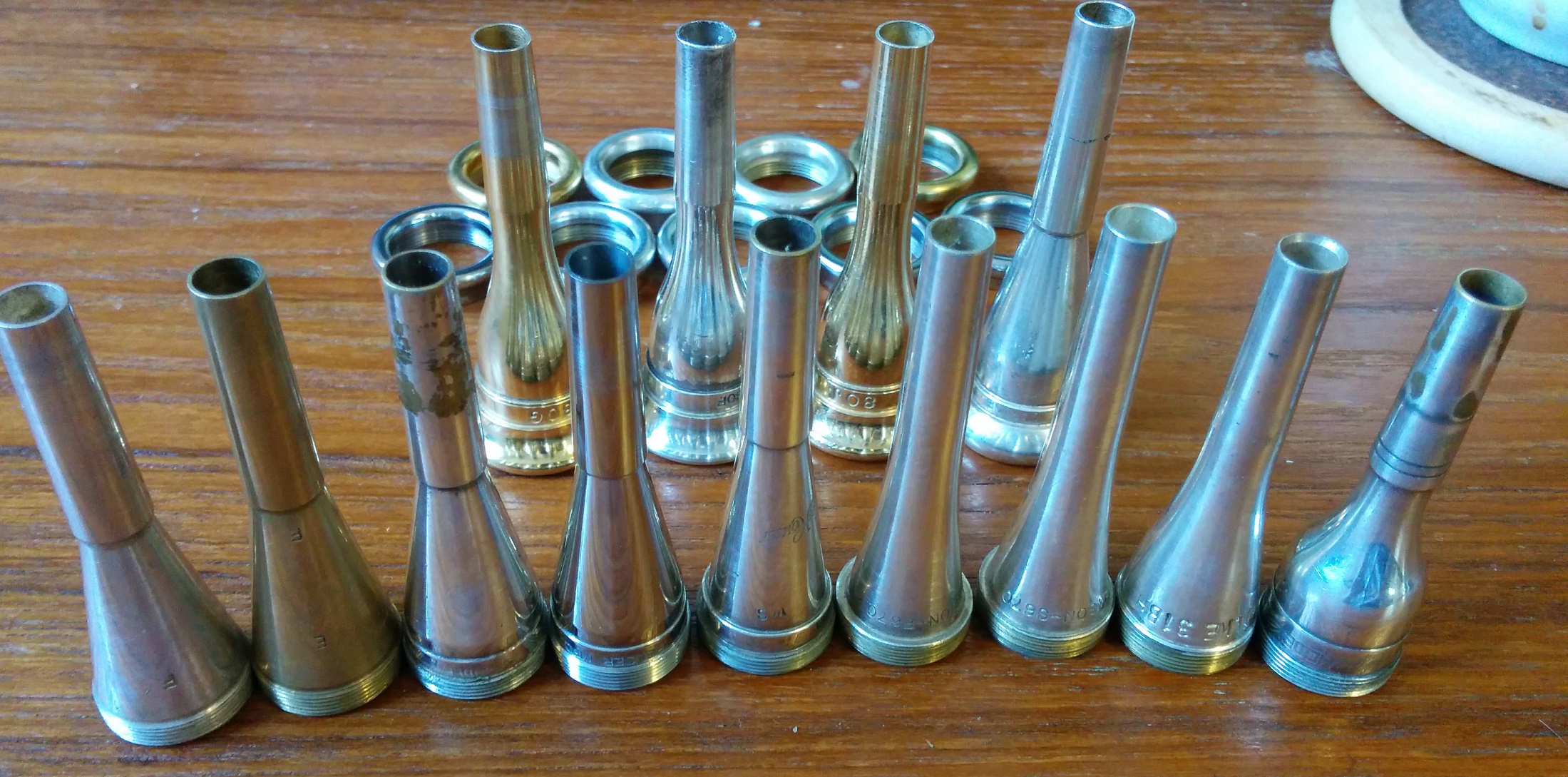Since two of the most popular pages on my site are related to French horn mouthpieces (Mouthpiece Comparison Chart and Choosing a Mouthpiece), I get lots of emailed questions about mouthpieces.
A Question About Range
One of the most common questions revolves around people having trouble with the mid-low register (from the E at the bottom of the treble clef to the F below that) or the upper register (from 3rd space C upward).
While it’s not always the case, one thing that many of these students have in common is that they are all using a similar mouthpiece setup – a Holton-Farkas MC or MDC mouthpiece.
With the school year starting soon, I thought this would be a good time to talk a bit about these mouthpieces and why I generally dislike them.
A (Brief) History of Holton-Farkas
The Holton-Farkas mouthpiece line has been around for a long time.
Phil Farkas was the principal horn of the Chicago Symphony for many years, first from 1936-1941 then (after brief stints playing principal horn in the Boston and Cleveland Symphonies) from 1948-1960.
He also had a legendary career as a pedagogue, teaching at schools like Indiana University, Northwestern University, the Cleveland Institute, and several others.
He also wrote several important books for horn and brass players. His The Art of French Horn Playing is still a great foundation for horn players, (and his book The Art of Brass Playing applies this same approach for all brass instruments). His book on musical interpretation, The Art of Musicianship is also great for more advanced players and those looking to deepen their musical vocabulary.
He was also influential in designing equipment for horn players – his Holton-Farkas line of horns were professional-level instruments at their introduction (and are still being made today!) and his Holton-Farkas mouthpieces presented one of the first logical and easily-understood mouthpiece sets – with sizes ranging from small to large.
Holton-Farkas Mouthpieces
When it was introduced in the 1950s, the Holton-Farkas line of mouthpieces was exceptionally easy to sort through.
Instead of vague model numbers, the six mouthpieces in the set were represented by a two- or three-letter code that described it’s overall dimensions relative to the other mouthpieces. The six models were:
(For specific measurements of these models, you can find them on my French Horn Mouthpiece Comparison page.)
However, one thing that all the models seem to have in common are internal rim diameters that are too small for a certain percentage of players.
Read my Choosing a Mouthpiece page to see why internal rim diameter is so important.
Each model has a slightly different internal rim diameter (and rim width), with the smallest being the MDC at 16.21mm and the largest being the DC at 17.07mm.
Holton-Farkas and “Horn Lips”
While I can’t say this for certain, this may be due to the idea (which I still here sometimes today) that there are certain players who have “French horn lips”.
French horn lips, as I understand them, are fairly thin and not very fleshy.
I don’t know where this term came about, but I can’t help wonder if the universal presence of the Holton-Farkas line of mouthpieces (which, along with the Holton-Farkas horns, were very popular among band directors) led to a sort of self-perpetuating cycle. These mouthpieces would work much better for horn players with thinner lips, so those people saw more success, so band directors would screen potential horn players for the “right” lip shape.
Even today, I run across band directors that look for “French horn lips” and only have the MC and MDC mouthpieces on hand for their horn players to use. No wonder!
Holton-Farkas Alternatives
While there are definitely lots of mouthpiece options available today, for middle and high school students, I recommend something middle-of-the-road and not too expensive.
For most students, this means a Yamaha 32C4. This mouthpiece is easy to find online, it’s very affordable, and it’s got a more reasonable 17.48mm internal diameter.
Yamaha also has the 33C4, 34C4, and 35C4 if you find that you need even more room. I find the 34C4 is probably the second-easiest to find in stock most places.
These are the mouthpieces I use for students who want to try something a little bit bigger – almost all of them sound better and extend their range (both up and down) within a couple of weeks.
For a more advanced high school (or college) player, I recommend investing in a 2-piece mouthpiece. This has the advantage of matching the mouthpiece cup to the horn, and the mouthpiece rim to your face. It does cost a little bit more, though.
Right now, my recommendations for 2-piece mouthpiece makers include Houser (and his Houghton line), Osmun, and PHC. There are plenty of other great makers that I don’t have experience with (Balu, WHF, Klier, Romera, etc) but I hear that they are also highly regarded.
If you have any questions about some of my mouthpiece recommendations, or anything else horn-related, don’t hesitate to contact me or leave a comment below.


Leave a Reply
You must be logged in to post a comment.